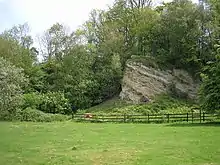Dryhill Nature Reserve
Dryhill is an 11.7-hectare (29-acre) geological Site of Special Scientific Interest on the western outskirts of Sevenoaks in Kent.[1][2] It is a Geological Conservation Review site,[3] and an area of 9.5 hectares (23 acres) is a Local Nature Reserve[4][5]
| Site of Special Scientific Interest | |
 | |
| Location | Kent |
|---|---|
| Grid reference | TQ 500 552[1] |
| Interest | Geological |
| Area | 11.7 hectares (29 acres)[1] |
| Notification | 1996[1] |
| Location map | Magic Map |
This former quarry exposes rocks dating to the Aptian stage in the early Cretaceous, around 120 million years ago. It is famous for its rich and diverse brachiopod and bivalve fossils, which are important for palaeoecological research.[6]
There is access from Dryhill Lane.
References
- "Designated Sites View: Dryhill". Sites of Special Scientific Interest. Natural England. Retrieved 2 February 2018.
- "Map of Dryhill". Sites of Special Scientific Interest. Natural England. Retrieved 2 February 2018.
- "Dryhill (Aptian-Albian)". Geological Conservation Review. Joint Nature Conservation Committee. Retrieved 11 January 2018.
- "Dryhill". Local Nature Reserves. Natural England. Retrieved 12 January 2018.
- "Map of Dryhill". Local Nature Reserves. Natural England. Retrieved 2 February 2018.
- "Dryhillcitation". Sites of Special Scientific Interest. Natural England. Retrieved 2 February 2018.
This article is issued from Wikipedia. The text is licensed under Creative Commons - Attribution - Sharealike. Additional terms may apply for the media files.